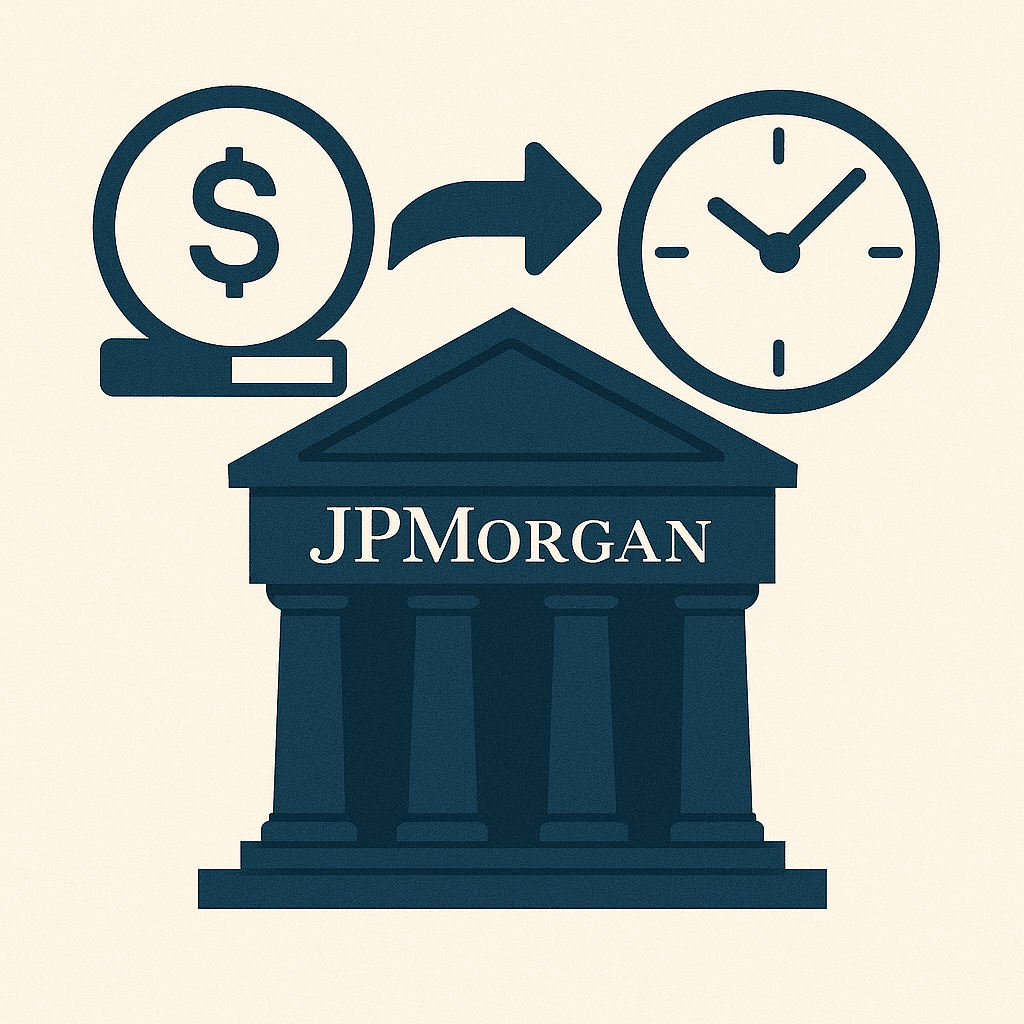Jamie Dimon's Stablecoin Awakening
"I think they're real, but I don't know why you'd want to use a stablecoin as opposed to just payment," JPMorgan Chase CEO Jamie Dimon said during the bank's July 15, 2025 earnings call. This wasn't just another crypto skeptic dismissing digital assets - this was the leader of a $10 trillion daily payment processor publicly admitting confusion about technology that's already reshaping global finance.
The irony? While Dimon puzzled over stablecoin payments, JPMorgan announced it would "be involved in both JPMorgan deposit coin and stablecoins to understand it, to be good at it." Translation: the world's most powerful bank just realized it's behind the crypto payment revolution, and it's scrambling to catch up.
Why This Matters for Your Business
Dimon's confession reveals something critical: traditional banks are reactive, not proactive, when it comes to programmable money and yield-generating payments. While he figured out what stablecoins for business actually do, smart companies moved to infrastructure that eliminates fees and generates revenue.
The Stablecoin Payment Revolution: Numbers Don't Lie
While Jamie Dimon remained confused, the stablecoin market moved without him. Stablecoins currently have a collective market capitalization of over $250 billion, and stablecoins last year processed about a fifth of Visa's volume in payments and over a quarter of Mastercard's.
Stablecoin Transaction Growth
17% year-over-year growth in stablecoin transaction volume
$1.7 trillion in adjusted stablecoin transactions YTD
$10.8 trillion worth of transactions settled in 2023
But here's what crypto payment processing skeptics miss: this isn't just about volume, it's about what becomes possible when payments run on programmable infrastructure.
The Real Cost of Traditional Payments
While traditional banks collect fees, businesses using legacy payment rails hemorrhage money:
Credit Card Processing Fees:
Stripe charges 2.90% plus $0.30 per transaction for online payments
2.70% plus $0.05 for in-person payments via Stripe Terminal
3.4% plus $0.30 for manually-entered card payments
Bank Transfer Costs:
ACH transfers: Take up to 4 business days to receive acknowledgement
International wire transfers: $8 per transaction on Stripe
SWIFT-based channels: $25 to $50 in fees, with 1–3 business days settlement
The Stablecoin Alternative: Meanwhile, transferring USDC via Solana blockchain typically costs less than $0.01 in network fees and settles in under 5 seconds.
The math is brutal: a $10,000 international business payment costs $50 and takes three days via traditional rails, or $0.01 and settles in seconds via crypto mobile payments.
Beyond Payments: The Programmable Money Revolution
This is where Dimon's confusion becomes costly. He sees stablecoins for treasury management as "payments," but that's like calling the internet "faster fax machines." The real opportunity isn't speed, it's programmability.
What Traditional Banking Can't Do
When payments run on blockchain payment infrastructure, suddenly every transaction can:
Generate yield instantly: Capital starts earning 6-8% APY the moment it's received
Include conditional logic: Smart escrows, milestone releases, automated subscriptions
Reverse safely: Cancel payments before settlement without complex chargebacks
Split automatically: Route portions to different accounts, shared yield, or automated taxes
Verify ownership: Cryptographic proof of funds without revealing balances
Real-World Programmable Payment Impact
Stripe launched Stablecoin Financial Accounts in May 2025, accessible to businesses in 101 countries, allowing companies to:
Hold balances in USDC and USDB stablecoins
Receive payments via both crypto and traditional fiat rails
Send stablecoins almost anywhere globally
Stripe announced they're taking a 1.5% fee on stablecoin payments, a 30% discount on traditional card payment fees. That's not just cheaper—it's profitable infrastructure competing directly with Dimon's $10 trillion daily flow.
The Fintech Tsunami: Why Banks Are Panicking
Dimon acknowledged that fintech firms are "very smart" and are "trying to figure out a way to create bank accounts and get into payment systems and rewards programs." His solution? "We have to be cognizant of that. Way to be cognizant is to be involved."
This isn't strategy, it's panic.
The Competitive Displacement
While JPMorgan played catch-up, fintech companies built entire business models around programmable payments:
Cross-Border Business Payments:
Instant settlement with 99% lower fees
No correspondent banking delays or fees
Real-time currency conversion at market rates
B2B Payment Automation:
Smart contracts handling invoice discounting and escrows
Automated recurring payments with yield generation
Pull-based payment systems that reduce operational overhead
Treasury Management:
Idle capital automatically generating yield instead of sitting in 0% accounts
Dynamic discounting based on projected yield returns
Multi-signature treasury operations with programmable approval workflows
Stripe's Acquisition Strategy: Stripe completed its acquisition of Bridge (a stablecoin platform) for around $1 billion, with Bridge having hit a $5 billion annualized payment volume run-rate. That's a startup processing significant volume with infrastructure that makes traditional banking rails look primitive.
Corporate Stablecoins and Regulatory ClarityThe GENIUS Act: Regulatory Green Light
The U.S. Senate passed the GENIUS Act on June 17, 2025, and the STABLE Act is pending in the House. This regulatory clarity is exactly what institutional adoption needed.
The White House issued the "Strengthening American Leadership In Digital Financial Technology" Executive Order on January 23, 2025, establishing a policy mandate "to promote the development and growth of lawful and legitimate dollar-backed stablecoins worldwide."
Key Regulatory Benefits:
Banks can issue compliant stablecoins
Clear framework for stablecoin treasury management
Protection for business stablecoin accounts
Institutional custody and compliance pathways
Corporate Stablecoins: The Ultimate Validation
Perhaps most telling: Amazon and Walmart are reportedly exploring issuing their own stablecoins, with both retailers spending an estimated $14 billion annually on card processing fees.
When retailers bypass payment networks entirely by issuing corporate stablecoins, traditional banking becomes an expensive middleman.
Corporate Stablecoin Benefits:
Eliminate interchange fees (2-3% savings immediately)
Direct customer relationships without payment network intermediaries
Programmable loyalty programs with yield-based rewards
Supply chain automation with smart contract payments
The Future of Business Banking: Beyond Zero Fees
While banks scramble to understand stablecoins, platforms like RebelFi are already building the next layer: programmable yield infrastructure for businesses.
The RebelFi Advantage: Turning Payments Into Profit
The vision isn't just cheaper payments, it's turning every business transaction into a revenue-generating workflow:
Zero-Fee Payment Processing:
Crypto point-of-sale systems that deposit directly into yield-generating protocols
Accept any token, settle in stablecoins, earn yield immediately
No merchant fees - revenue from yield sharing instead
Pull-Based Payment Systems:
Senders earn yield until recipients collect payments
Cancelable transfers with built-in security features
Automated payroll and vendor payment workflows
Smart Business Banking:
High-yield stablecoin accounts for treasury management
Dynamic invoice discounting using projected yield calculations
Programmable escrows that automate business logic
DeFi Treasury Integration:
Capital automatically deployed to highest-yielding protocols
Real-time yield optimization across multiple DeFi platforms
Non-custodial control with institutional-grade security
Transforming Payment Economics
This transforms the fundamental economics: instead of payments being a cost center (2-3% fees), they become a profit center (6-8% yield on float).
Real Business Impact:
Walmart's $648B revenue could save $10 billion annually in processing fees
Small businesses earning yield on payment float instead of paying fees
B2B companies reducing working capital costs through yield-generating escrows
Your Move: Stop Subsidizing Competitors
Jamie Dimon's confusion isn't just about stablecoins, it's about recognizing when entire industries shift overnight. Stablecoin transaction volume is growing by 17% year-over-year, while traditional banking infrastructure becomes more expensive and less competitive daily.
The Competitive Timeline
Q2 2025: GENIUS Act passes, corporate stablecoin pilots launch
Q3-Q4 2025: Full-scale corporate stablecoin adoption
2026: Programmable payment infrastructure becomes standard
Key Action Items for Businesses
Evaluate payment processing costs: Calculate annual fees paid to Stripe, Square, and traditional processors
Explore stablecoin treasury accounts: Research yield-generating alternatives to traditional business banking
Test crypto payment acceptance: Start with stablecoin payments for international transactions
Assess programmable payment needs: Identify use cases for escrows, automated payouts, and yield optimization
The companies winning aren't the smartest ones. They're the ones who stopped making excuses and started using infrastructure that actually works.
Every day you wait, your competitors gain an advantage that compounds. How much longer are you subsidizing their head start?
Conclusion: The Stablecoin Business Banking Revolution
Jamie Dimon's admission that he doesn't understand why businesses would want stablecoins for payments reveals the massive opportunity gap between traditional banking and programmable finance.
While JPMorgan scrambles to understand stablecoin business accounts, forward-thinking companies are already benefiting from:
Zero-fee payment processing with instant yield generation
Programmable treasury management that maximizes capital efficiency
Automated business workflows powered by smart contracts
Global payment rails with sub-second settlement times
The stablecoin payment revolution isn't coming, it's here. The question is whether your business will lead or follow.
Ready to explore crypto payment processing for your business? RebelFi's programmable yield infrastructure turns every transaction into a revenue opportunity. Learn more about our stablecoin business banking platform and discover how yield-generating payments can transform your company's financial operations.



